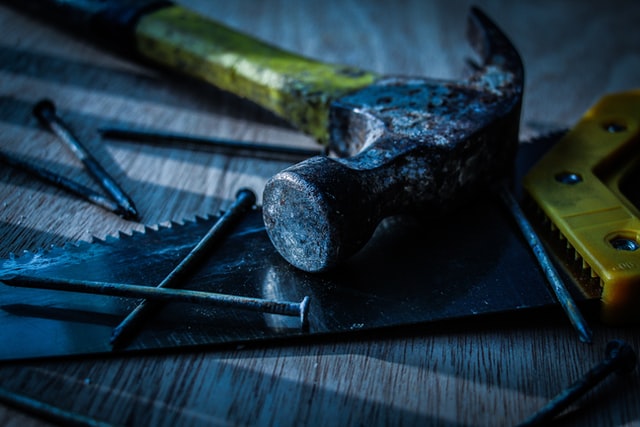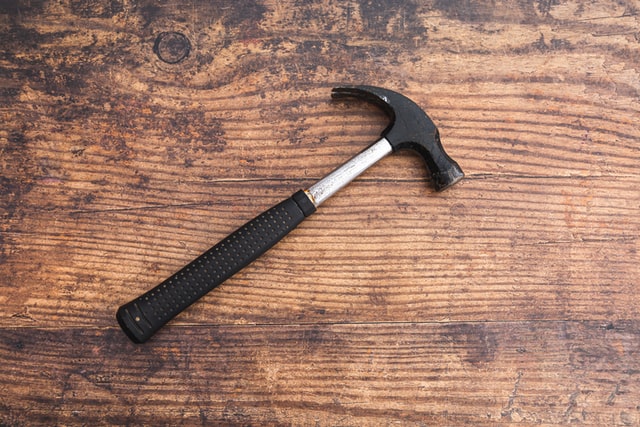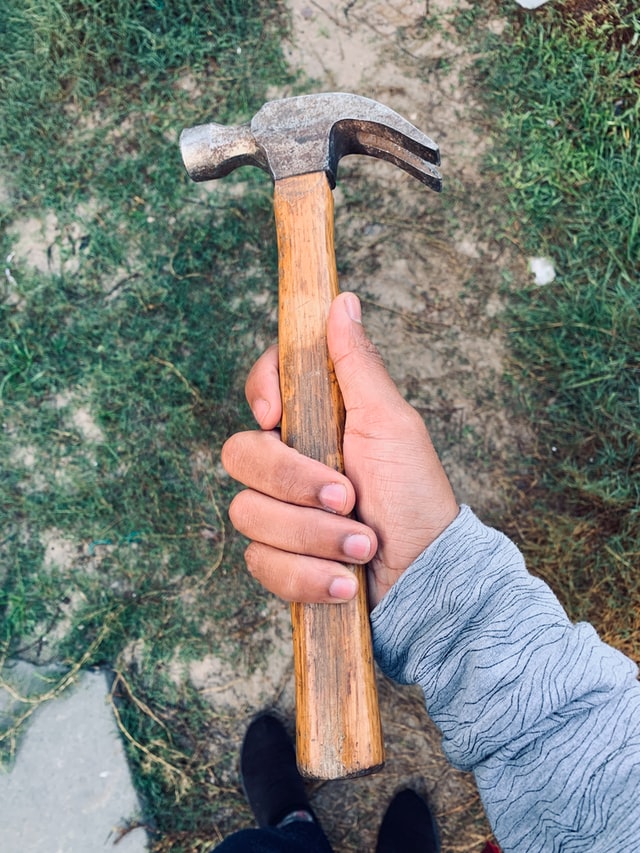Have you ever seen a carpenter who did not use a hammer in their construction work? Well, it is not surprising if your answer is no as this tool is an important one within the construction world. Some assume that any type of hammer can be used, but this is not actually the case. In terms of the framing hammer vs claw hammer, you may notice that there is still a difference between them.
If you want to know more about their distinction, we have here their unique characteristics and uses. Moreover, the two types of the hammer are differentiated to discover which one is an appropriate tool for your job. Check them out below!

What is a Claw Hammer?
Generally, one of the most important tools in the construction industry is the claw hammer. This is actually a must-have tool for every carpenter or even for a repairman or DIYer. Basically, the main function of the claw hammer is to pound nails deep down the wood. Typically, the claw hammer has a weight of around 16 to 25-ounces.
Made from stainless steel, the head of the claw hammer is generally sturdy and robust. Moreover, the material that makes the handle of this hammer type is either fiberglass or steel as well. Usually, the best claw hammer comes with a comfortable grip and has an ergonomic design ensuring the prevention of cramps within wrist and hands while using it.
As you can see, one portion of the head is smooth and actually flattened. Meanwhile, the other part has a claw for the purpose of nail extraction. Due to this, you may realize how unique and impressive the creation of the claw hammer is. However, it is still highly essential to look for the appropriate hammer for your project.
Detailed design of the claw hammer
Typically, the appearance of the claw hammer resembles the T-shape giving the handle the long portion of this tool. Yet, the head of the claw hammer is not actually a straight line but it forms a curve gearing into the claw. Moreover, there is a V-shape that splits into the middle. And the combination of the claw end plus the comfortable handle offers powerful leverage in taking out the nail.
Uses of the claw hammer
Generally, in an everyday construction task, the claw hammers are the tool for the job. Below are the most common uses of the claw hammer:
- Either pound the nails using the head part and extract the nails within the wood through the hammer’s claw which resembles a V-like shape that fits snugly around the nails.
- Highly suitable for woodworking activities
Basically, making life easier is the main goal of the claw hammer. A serious repair that calls for immediate attention necessitates the use of the claw hammer for a woodworking project.
What is a framing hammer?
After learning something about the claw hammer and its uses, it is time to discover everything about the framing hammer. Generally, this will help us to determine the difference of framing hammer vs claw hammer. Yet, the truth is there is really not much difference between framing hammer vs claw hammer.
Uses of the framing hammer
Basically, framing hammer intends to put up the foundation of the object you are making. Literally speaking, framing hammer is used for framing. It helps in building the 2×4 and 4×6 base of your house, the barn, or the garage. But, finishing a product is not the goal of a framing hammer.
Generally, framing hammer is really helpful in driving out tons of 12D quarter inch nails around the frame of the garage. Besides, you may notice that carpenters bring along with the pair of hammers which includes the framing hammer most of the time.
What makes framing hammer unique from the rest?
There are actually lots of distinctions that make framing hammer standout from the rest. Primarily, one of the unique features of the framing hammer is their weight. The framing hammer seems to be heavier compared to the standard hammer. Bear in mind that the standard hammer has a weight of only about 12 to 14-ounces.
Typically, the framing hammer starts its weight on 20-ounces and can elevate up until 22-ounces. The large size of the framing hammer is generally intended for power. Remember that driving the 3 1/2–inch long 16D nails necessitates an extra weight in pounding them.

Unlike the standard hammer that entails a smooth surface referring to it as its face, the framing hammer usually has an edge or a waffle. That’s why the other term for framing hammer is the “waffle face” with the serrated jaw. The purpose of this feature of the framing hammer is for additional grip. Moreover, the presence of indentations within the face supports the nails in gripping and preventing them from slipping.
Lastly, the framing hammer has a longer handle compared to the standard hammer. As you can see, the standard hammer entails 13 to a 14-inch long handle. Meanwhile, a framing hammer has handle measuring 16 to 18-inch long. This is actually for the purpose of incorporating more leverage and power on every swing.
Differences between framing hammer vs claw hammer
After knowing the characteristics of each hammer type, it is also important to identify the exact difference between framing hammer vs claw hammer. Generally, a framing hammer with a common name of rip hammer as well is also categorized as a claw hammer. This may be very daunting but if you look a little bit closer, there will be some features that separate the framing hammer from the claw hammer.
Framing hammer vs claw hammer – the head shape
Both the framing hammer and the claw hammer have waffled head. This waffling feature avoids slipping off the head nail. But, the difference that comes along the framing hammer vs claw hammer in terms of their head shape is that the head of the claw hammer is textured which is a little bit smoother.
Moreover, the head of the claw hammer also has doomed appearance on its face. This highly guarantees the possible damage onto the surface. Basically, this claw hammer feature on its head may not be seen over a framing hammer.
Framing hammer vs claw hammer – the design and performance
Although these two hammers are under the same category, their design allows them to perform a unique and specific task. Due to the flattered head of the framing hammer, it is preferably used for mounting and ripping. Moreover, if you compare framing hammer vs claw hammer, the curved claws of the claw hammer make it to perform hammering and driving of nails. Besides, the curved claws have deep arc located on one side which allows to pivot better thus requiring less effort in removing nails.
Framing hammer vs claw hammer – the weight
The head.of the standard framing hammer has a normal weight of 20 to 32-ounce. Meanwhile, the domestic claw hammer weighs around 10 to 16-ounces. But, does this matter in differentiating the framing hammer vs claw hammer?
Generally, the effectiveness of the two hammers highly depends on the type of their work. Opting for the appropriate one will highly save you more energy and may let you perform the more professional task. However, framing hammer will require you some time to pound large nails
Framing hammer vs claw hammer – the handle
Basically, one of the distinctions of the framing hammer vs claw hammer is the handle that also helps them to do their purpose. The claw hammer generally remove nails and also ripped out lumber. The wooden handle is the most common type of handle for claw hammer as it comes from a hardwood called hickory. However, even if it’s hard, once missed the nail, the handle can easily break.
Usually, the handle can also be sourced out from a steel material which tends to be more durable. Yet, the problem for this handle material is that shock absorption is not possible while hitting. This is one of the framing hammers. Moreover, fiberglass handle also is a type of framing hammer handle which is becoming popular. The fiberglass handle made its way to popularity due to its high durability and shock and vibration absorbing property.
Generally, a rubberized material covers both the steel and fiberglass handle to provide extra comfort and better grip. Moreover, these two handle materials can also be found on claw hammer aside from the wooden handle. Yet, the wooden one does not have or just little grip which may make the hand slides off more often.

Rubber handles with poor quality for framing hammer vs claw hammer has the potential to separate from the head of the hammer which may injure the user. Further, there are few carpenters or hammer users who prefer the no or little grip feature of the wooden handle. They usually start a stroke by gripping the handle gearing to the center.
Eventually, this permits the handle to slide along the hand through swinging. This action generally allows more control at the starting phase of the stroke. Yet, the leverage increase and more there is more power once the hammer strikes the nail.
Final Thoughts
Hammer is generally an important tool for carpenters which is present for more years now and it seems to exist as long as construction works will be there on our daily activities. Generally, the hammer will still remain as the most affordable and convenient way to strike down nails even for the innovation and utilization of nail gun. Actually, choosing the appropriate hammer for a specific task will basically save your time and energy.
In terms of differentiating the framing hammer vs claw hammer, their performance is really dependent on the type of their work like framing or nailing. There are still similarities that can be seen between these two hammers. Yet, few differences still exist like the shape of their head, the weight, and their handles. So, choosing between the two depends necessary on your working needs.


